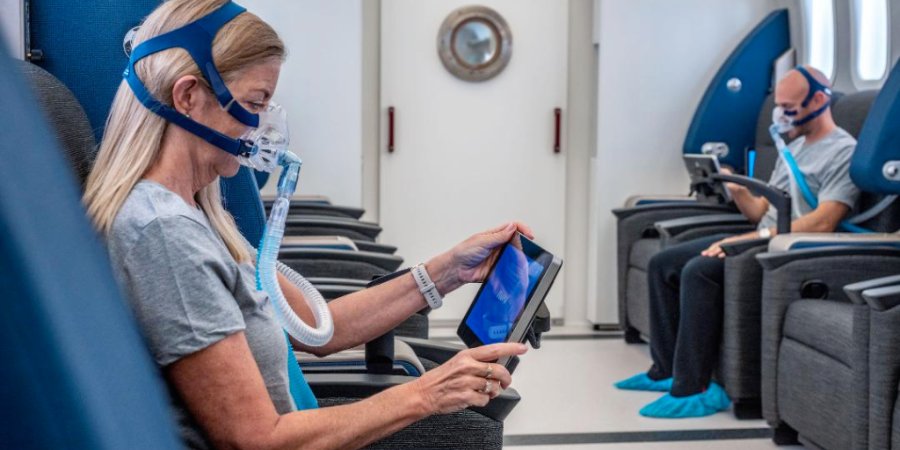How Often Should You Use a Hyperbaric Chamber for Oxygen Therapy?

Hyperbaric Oxygen Therapy (HBOT) has been a topic of interest in the NYC medical community and those seeking holistic wellness treatments. By allowing patients to breathe pure oxygen in a pressurized room or chamber, HBOT has shown promise in treating various medical conditions. But one frequently asked question about this therapy is, "How often should one use a hyperbaric chamber?" Let's dive into the details.
What is Hyperbaric Oxygen Therapy (HBOT)?
Before discussing frequency, it's essential to understand what HBOT is and how it works. Hyperbaric Oxygen Therapy involves breathing 100% oxygen in a chamber with increased and controlled atmospheric pressure. This process helps increase the blood's oxygen-carrying capacity, allowing it to better deliver to the body's tissues, promoting faster healing and reducing inflammation.
What Are The Medical Uses of HBOT
Hyperbaric Oxygen Therapy (HBOT) involves the administration of 100% oxygen to patients in a pressurized chamber. By elevating the oxygen content in the bloodstream, HBOT has the potential to amplify the body's innate healing mechanisms, and it finds applications in treating a wide range of medical conditions. If you're looking for hyperbaric chamber therapy, you can explore local facilities that offer this treatment.
Here are some of the primary medical applications for HBOT:
Carbon Monoxide Poisoning
Carbon monoxide is an invisible, scentless gas that can result in poisoning when breathed in. It binds to hemoglobin in the blood, preventing oxygen from being effectively transported to tissues. HBOT helps displace the carbon monoxide and rapidly deliver oxygen to compromised tissues.
Chronic Non-healing Wounds
Conditions like diabetic foot ulcers can benefit from HBOT. Enhanced oxygen delivery can stimulate healing in tissues that aren't healing under standard conditions.
Necrotizing Soft Tissue Infections
These are severe, rapidly progressing bacterial infections that can destroy muscle, skin, and underlying tissue. HBOT can be a supplementary treatment, aiding in halting the condition's progression.
Decompression Sickness
Often known as "the bends," decompression sickness is hazardous for scuba divers who surface too quickly. The condition arises when dissolved gasses in the body form bubbles, leading to joint pain, neurological symptoms, and other complications.
Radiation Injury
Patients who undergo radiation therapy for cancer might sometimes experience radiation burns or delayed injuries, known as osteoradionecrosis. HBOT can assist in healing these radiation-induced wounds.
Gas Embolism
This occurs when gas enters the circulatory system, which can be life-threatening. HBOT is considered a primary treatment for arterial gas embolism.
Acute Traumatic Ischemia
Injuries like crush injuries or compartment syndromes can lead to reduced blood flow to tissues. HBOT can help improve oxygen delivery to these ischemic tissues.
Thermal Burns
By enhancing oxygen delivery, HBOT can support healing in patients with burn injuries.
Can I Undergo HBOT Every Day?
Many patients undergo hyperbaric oxygen therapy (HBOT) daily, especially for specific conditions. Daily treatments are common for many standard HBOT protocols. Here's what you should know:
Acute Conditions
HBOT might be administered more than once in 24 hours for acute conditions like carbon monoxide poisoning or decompression sickness, based on the severity and the patient's response.
Chronic Conditions
For chronic conditions, such as diabetic foot ulcers or radiation tissue damage, daily treatments (often five to seven days a week) are standard. The course can last several weeks, with sessions ranging from 20 to 40 or more.
Treatment Duration
Each session usually lasts between 60 and 120 minutes. Still, the exact duration can vary based on the specific condition being treated and the prescribed protocol.
Rest Periods
While many patients receive HBOT daily, some protocols or individual patient needs may call for breaks or days off between treatments. This can minimize potential side effects or give the body time to respond to the therapy.
Monitoring
Regular assessment by a healthcare provider is crucial, especially if undergoing daily treatments. This guarantees the effectiveness of the therapy and early identification and management of any potential side effects.
Potential Side Effects
Although HBOT is generally considered safe, daily treatments can elevate the potential for specific side effects, such as ear barotrauma or oxygen toxicity. It's essential to be aware of potential symptoms and to communicate any concerns to the treating physician.
Are There Any Side Effects From Frequent Use Of HBOT?
Hyperbaric oxygen therapy (HBOT) is generally considered safe, but like all medical treatments, there are potential side effects. Using HBOT frequently or for extended periods can elevate the risks of specific side effects.
Here are some potential side effects from HBOT:
Barotrauma
The most common side effect is barotrauma, which can affect the ears, sinuses, or lungs. This is due to the changes in pressure inside the chamber. Symptoms might include ear pain, fluid buildup, or a ruptured eardrum.
Oxygen Toxicity
Oxygen toxicity occurs when someone breathes excessive amounts of oxygen for an extended period. This can affect the lungs (pulmonary oxygen toxicity) or the central nervous system (CNS oxygen toxicity). CNS oxygen toxicity can manifest as twitching, seizures, dizziness, or vision changes.
Myopia
Some patients experience temporary nearsightedness (myopia) after undergoing several HBOT sessions. This vision change is usually reversible once treatments are discontinued.
Sinus or Nasal Congestion
The changes in pressure can cause sinus or nasal congestion for some individuals.
Fatigue
Some people report feeling tired after HBOT, although this is usually temporary.
Claustrophobia
Though not a direct side effect of the oxygen or pressure, the confined space of the chamber can lead to feelings of claustrophobia in some patients.
Bottom Line
Hyperbaric Oxygen Therapy has shown significant promise in treating various medical conditions, ranging from acute emergencies like carbon monoxide poisoning to chronic issues like diabetic foot ulcers and radiation injuries. The frequency of HBOT sessions depends on the specific condition being treated, with daily treatments common for many patients.
If you're considering HBOT in New York City, there are reputable facilities that offer this therapy. It is essential to seek guidance from a healthcare provider to assess whether HBOT is suitable for your individual needs and to collaborate on establishing the appropriate treatment plan.
More to Read:
Previous Posts:











